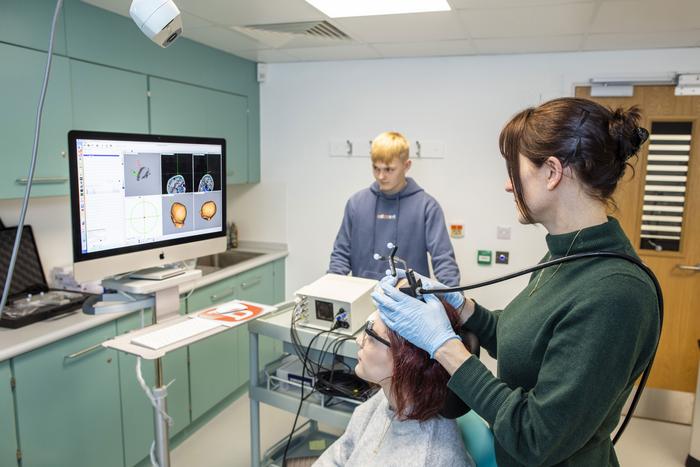The targeted use of ultrasound technology can bring about significant changes in brain function that could pave the way towards treatment of conditions such as depression, addiction, or anxiety, a new study suggests.

Credit: University of Plymouth
The targeted use of ultrasound technology can bring about significant changes in brain function that could pave the way towards treatment of conditions such as depression, addiction, or anxiety, a new study suggests.
Research by neuroscientists at the University of Plymouth explored the impacts of an emerging technique called transcranial ultrasound stimulation (TUS).
Typically, ultrasound examinations involve diffuse broad beams of ultrasound being used to create images while leaving the target tissue unaffected.
However, focusing the beams through TUS can increase the pressure in the target region and change the way neurons communicate with one another.
Writing in Nature Communications, the research team say a study involving 24 healthy adults showed that TUS can induce significant changes in GABA (gamma-aminobutyric acid) concentration within the brain’s posterior cingulate cortex in the hour following ultrasound treatment.
The study also showed that in the hour following the TUS treatment, the way the posterior cingulate cortex communicates with the rest of the brain was also profoundly altered.
However, the changes were not consistent across all areas with GABA levels not being altered in the anterior cingulate cortex, another cortical area equally related to psychiatric conditions but underlying different cognitive functions, particularly related to decision making, learning and attention regulation.
The research team – which also included experts from the University Hospitals Plymouth NHS Trust, University College London, Radboud University Nijmegen, and University of Oxford – say the study represents an important first step in the generation of clinical applications that could use ultrasound to treat mental health disorders.
They say the study provides evidence that TUS works in humans and that changes in the brain are reversible, although much more work will need to be done before it can be applied in a clinical setting.
They are already exploring whether TUS can be used to change the dopaminergic system, which could potentially alter how people make decisions, learn, and are motivated to engage in certain behaviours relevant to addiction.
Senior author Dr Elsa Fouragnan, Associate Professor of Neuroscience at the University of Plymouth and a UK Research and Innovation Future Leaders Fellow, said: “One of the long-term aspirations of neuroscientists is to find ways to change activity in only certain parts of the brain while leaving the rest unchanged. If you are taking medication for depression, for example, the drug will impact the entire brain and clinicians have very limited control over where the drug goes and what it does. We already know that specific regions of the brain (and some of their connections) are dysfunctional in certain conditions but other regions can work perfectly well. This study provides us with the genuine potential to think about using ultrasound for more targeted interventions in people with a range of mental health conditions.”
Dr Siti Yaakub, a Postdoctoral Research Fellow at the University and the study’s lead author, added: “It was very interesting to see that when we targeted two different brain regions, it resulted in different changes in GABA concentration. This suggests that some TUS protocols work well for certain parts of the brain and not so well for others. Or maybe there is another mechanism at play, like the fact that the region needs to be in a certain state for the intervention to work, and that is something we clearly need to explore more in future work.”
The study was carried out at the University of Plymouth’s Brain Research and Imaging Centre, a state-of-the-art research facility opened in 2022 to help better understand brain activity and human behaviour.
It is the latest project involving the University to explore the impact of ultrasound on the human brain, with previous studies highlighting how ultrasound could be used to treat psychiatric disorders and change the decision-making process.
Journal
Nature Communications
DOI
10.1038/s41467-023-40998-0
Method of Research
Experimental study
Subject of Research
People
Article Title
Transcranial focused ultrasound-mediated neurochemical and functional connectivity changes in deep cortical regions in humans
Article Publication Date
1-Sep-2023




